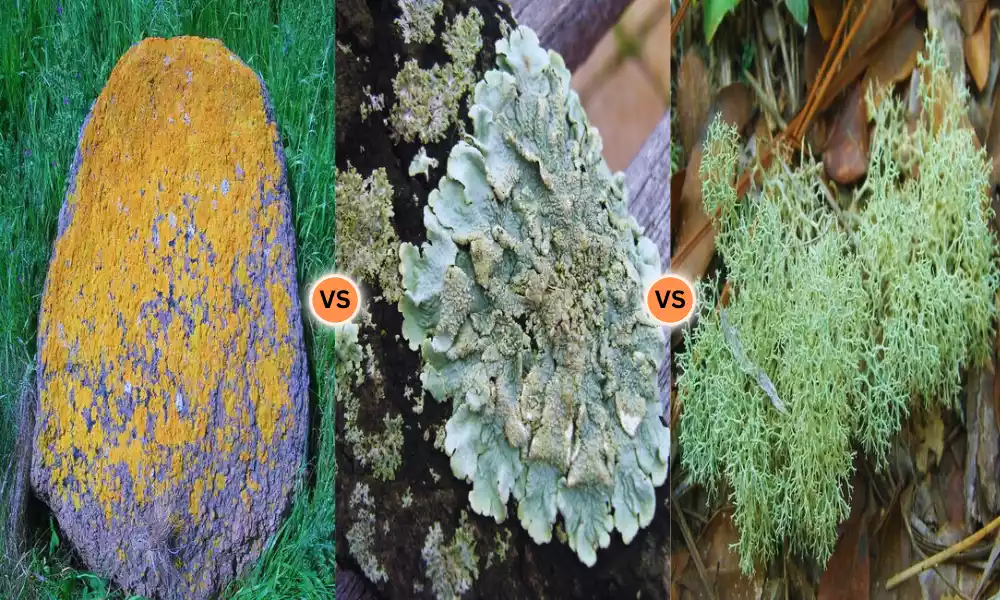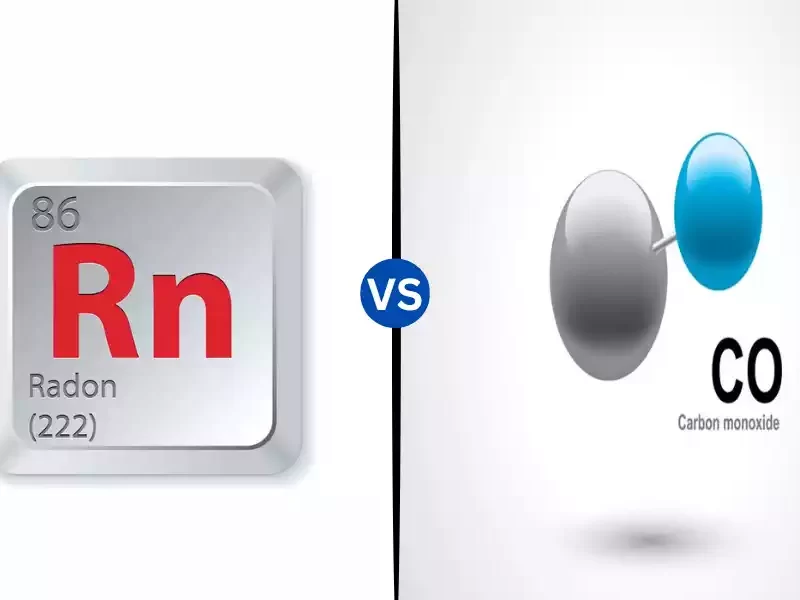Crustose Foliose and Fruticose Lichens are the three primary types of lichens, each distinguished by its unique morphology and growth form. Crustose lichens are flat and closely adhered to their substrates, often resembling a crusty layer on surfaces like rocks or tree barks. Foliose lichens, with their leaf-like structures, have a somewhat more raised profile and are partially attached, making them appear as if they are slightly peeling off their substrate.
Fruticose lichens stand out with their shrubby or hair-like growth, either dangling down or shooting upwards. These varied forms of lichens can be found in diverse environments worldwide, showcasing nature’s adaptability and creativity.
Definition of Crustose Lichens
Crustose lichens are a growth form of lichens characterized by a crust-like, tightly adhering thallus that grows closely attached to its substrate, often giving the appearance of being painted on. Unlike other lichen forms, they lack an identifiable lower surface and are typically inseparable from the substrate without causing damage. They can be found on various surfaces, including rocks, tree bark, and soil, and can exhibit a range of colors and patterns.
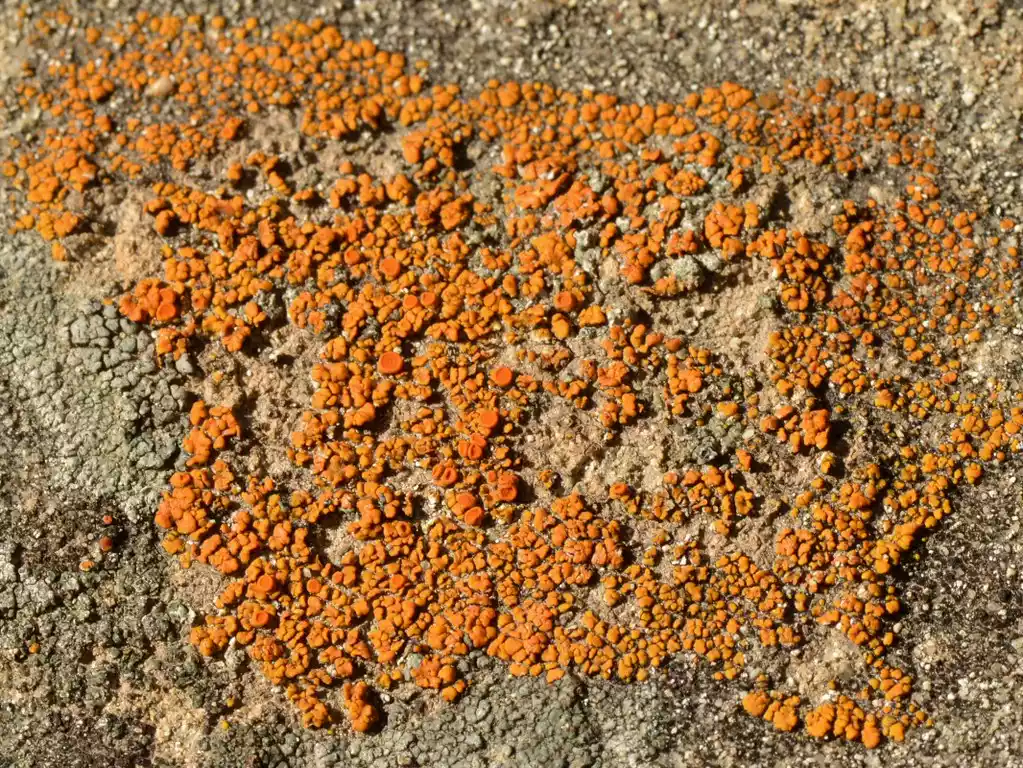
Characteristics of Crustose Lichens
Crustose lichens exhibit several distinct characteristics that set them apart from other lichen forms. Here are the key characteristics of crustose lichens:
-
- Tight Adhesion: Crustose lichens are closely and firmly attached to their substrate. Due to their strong adhesion, they often cannot be removed without taking a piece of the substrate with them.
- Flat Appearance: Their thallus (the body of the lichen) is typically flat, giving them a crust-like appearance. This makes them look as if they’ve been painted or etched onto surfaces.
- Lack of Lower Surface: Unlike foliose or fruticose lichens, crustose lichens do not have a distinguishable lower surface. The thallus is often undifferentiated.
- Variety of Substrates: They can colonize a range of substrates, from rocks and walls to the bark of trees. Their ability to thrive on hard surfaces makes them pioneer species in many ecosystems.
- Colors and Patterns: Crustose lichens can come in a variety of colors, from muted grays and whites to vibrant oranges, reds, and yellows. The patterns they form can be intricate and are sometimes used as bioindicators of air quality.
- Reproductive Structures: They possess specialized structures for reproduction. While they can produce spores, many crustose lichens also reproduce asexually through structures like soredia and isidia.
- Ecological Role: As pioneer species, they play a vital role in starting the process of soil formation on bare rocks by aiding in the breakdown of rock and contributing organic matter.
- Sensitivity to Pollution: Many crustose lichens are sensitive to certain air pollutants, making them valuable bioindicators of air quality in various regions.
Crustose lichens are a unique and integral form of lichen that play significant ecological roles and possess distinct characteristics that differentiate them from other lichen forms.
Habitats & Distribution
Crustose lichens can be found in a wide range of habitats and are widely distributed around the world. Their resilience and adaptability allow them to colonize various substrates in diverse environments. Here’s an overview of their habitats and distribution:
- Global Distribution: Crustose lichens have a cosmopolitan distribution, meaning they can be found on every continent, from the icy landscapes of Antarctica to the tropical rainforests of the Amazon.
- Mountainous Regions: They are commonly found at high altitudes on mountain rocks and boulders. Their resistance to harsh UV rays, cold temperatures, and desiccation allows them to thrive in these extreme environments.
- Coastal Areas: Some crustose lichens are adapted to live in coastal areas, enduring salt spray and fluctuating moisture levels.
- Deserts: Even in arid regions with extreme temperature fluctuations, crustose lichens can be found on rocks, providing vital ecosystem services like preventing erosion.
- Forest Ecosystems: On tree bark, especially in older or undisturbed forests, crustose lichens can be abundant, providing a unique appearance to tree trunks and branches.
- Urban Environments: Crustose lichens can be seen on brick walls, concrete structures, and even gravestones in cemeteries. However, their presence and diversity might be influenced by the level of air pollution.
- Tundra: In the cold tundra regions, crustose lichens grow on both soil and rocks, providing food for some herbivores, such as reindeer or caribou.
- Rainforests: Even in the wet and humid conditions of rainforests, these lichens manage to colonize tree barks and rocks.
- Caves and Overhangs: Some species thrive in the low-light environments of caves, grottos, and rock overhangs.
Crustose lichens’ wide distribution and ability to colonize a diverse range of habitats is a testament to their adaptability and ecological importance. Whether acting as primary colonizers, breaking down and weathering rocks, or serving as indicators of environmental health, they play a vital role in many ecosystems globally.
Definition of Foliose Lichens
Foliose lichens are a type of lichen characterized by a leaf-like, flattened structure. Unlike the closely adhered crustose lichens, foliose lichens are only loosely attached to their substrate, typically by small root-like structures called rhizines. Their thallus (body) is differentiated with distinguishable upper and lower surfaces. This growth form resembles foliage, which is how they get their name. They can be found on various surfaces, including rocks, soil, and tree bark, and can be easily peeled or removed from the substrate without causing much damage.
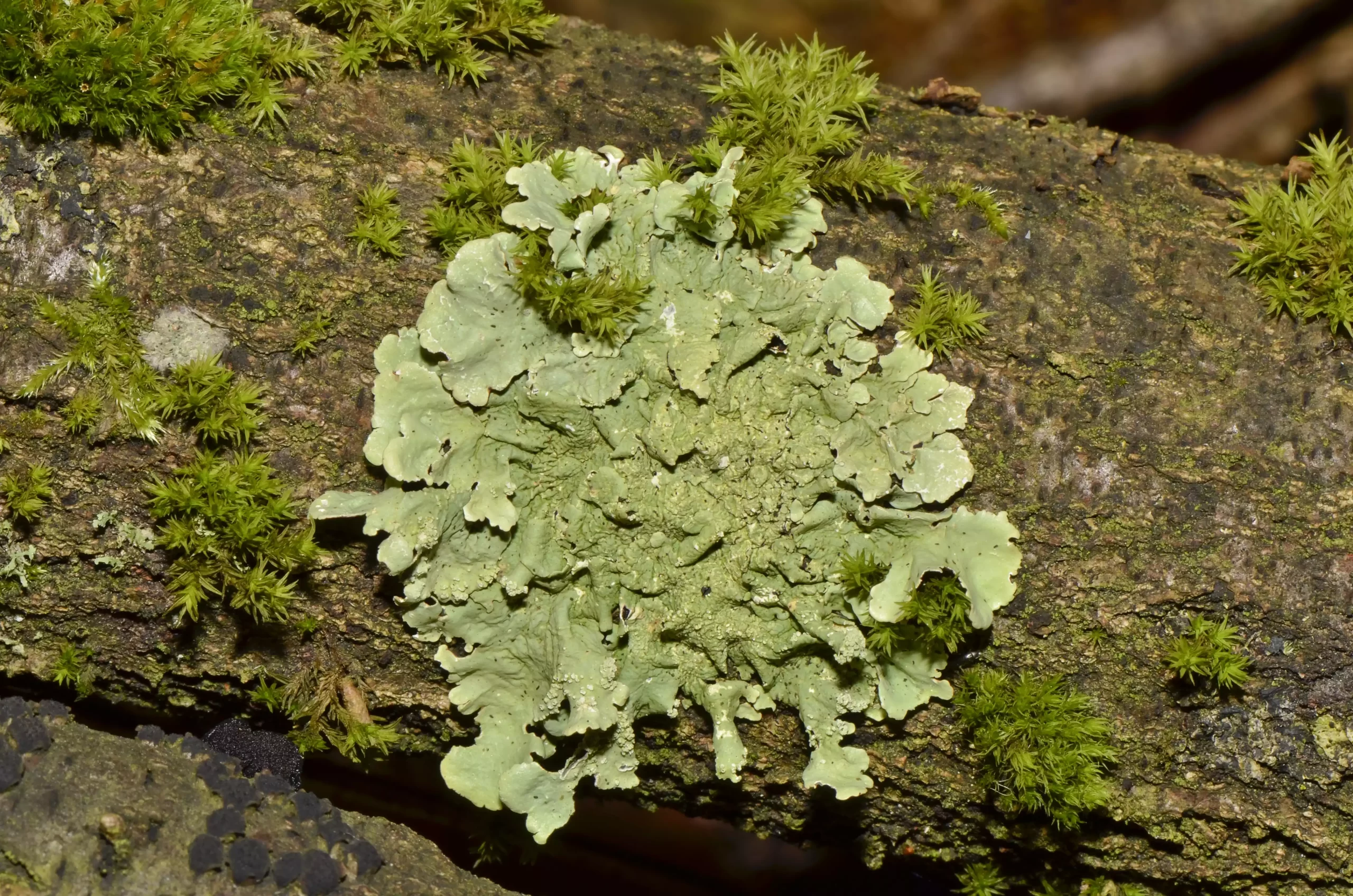
Characteristics of Foliose Lichens
Foliose lichens exhibit several distinct characteristics that differentiate them from other lichen growth forms:
-
- Leaf-like Structure: As the name suggests, foliose lichens have a leafy appearance, with their thallus (body) being flat and somewhat flexible.
- Differentiated Thallus: The thallus of foliose lichens is typically differentiated into distinguishable upper and lower surfaces. The upper surface is often more pigmented and may be smooth, wrinkled, or even slightly lobed. The lower surface can be lighter in color and may have various structures like rhizines.
- Loose Attachment: Unlike crustose lichens, which are tightly bound to their substrate, foliose lichens attach more loosely. They typically use structures called rhizines to anchor themselves to the substrate.
- Variability in Size: Foliose lichens can range from small patches to much larger expanses. Some may be just a few millimeters wide, while others can span several centimeters.
- Reproductive Structures: Foliose lichens possess various reproductive structures. They can produce apothecia (disk-like structures) that house fungal spores. Some also have structures like soredia and isidia for asexual reproduction.
- Color and Texture: The upper surface of foliose lichens can exhibit a range of colors, from greens and grays to browns and even yellows, depending on the species and environmental conditions. The texture can vary too, from smooth to ridged or bumpy.
- Habitats: They are versatile and can be found in various habitats, from forests and grasslands to rocky terrains and urban environments. Their preference for certain substrates can vary, but they commonly grow on tree bark, rocks, and soil.
- Sensitivity to Environment: Like many lichens, some foliose species are sensitive to pollution and environmental changes, making them valuable indicators of ecological health.
Foliose lichens are a diverse and widespread group, with a leaf-like appearance and various unique characteristics that set them apart from other lichen forms.
Habitats & Distribution
Foliose lichens, with their distinctive leaf-like structures, have a broad distribution and can be found in a variety of habitats around the world. Here’s an overview of their habitats and distribution:
- Global Distribution: Like crustose lichens, foliose lichens also have a cosmopolitan distribution, meaning they are found on every continent, from the tropical regions to polar areas.
- Forests: One of the most common habitats for foliose lichens is forests, both temperate and tropical. They often grow on tree trunks and branches, benefiting from the moderate light and moisture conditions.
- Mountainous Regions: Foliose lichens can also be found at various altitudes in mountain regions, both on rocks and vegetation.
- Arctic and Alpine Zones: In cold alpine and Arctic regions, foliose lichens can be found on rocks and soil. They serve as an important food source for animals, such as reindeer and caribou, especially during the winter.
- Grasslands and Prairies: In these open habitats, foliose lichens might colonize soil, rocks, or the bases of shrubs and trees.
- Deserts: Even in some arid regions, certain resilient foliose lichens can be found, especially in shaded or periodically moist microhabitats.
- Urban Areas: Due to their adaptability, some species of foliose lichens have made their way into urban areas, growing on trees, walls, and other man-made structures. However, the diversity and abundance can be impacted by air pollution levels.
- Coastal Areas: The moisture from sea sprays provides a conducive environment for some foliose lichen species, allowing them to thrive on rocks and cliffs near the coast.
- Islands: From temperate to tropical islands, foliose lichens can be a common sight, often benefiting from the relatively stable climatic conditions.
- Rainforests: In the dappled light of rainforest canopies, foliose lichens can be found adorning tree trunks and branches, often in association with other epiphytes.
Their widespread distribution and adaptability to various habitats underscore the ecological importance and resilience of foliose lichens. They play roles in nutrient cycling, soil stabilization, and providing habitat and food for various organisms.
Definition of Fruticose Lichens
Fruticose lichens are a growth form of lichens characterized by their shrubby or bushy, three-dimensional structures. Unlike the flat profiles of crustose and foliose lichens, fruticose lichens are branched and stand out from the substrate. They can be pendant, hanging like moss from tree branches, or upright, growing vertically from the ground or other surfaces. The entire structure, including the branches and stems, is known as the thallus. Fruticose lichens can be found on a variety of substrates, from soil and rocks to tree bark and branches.
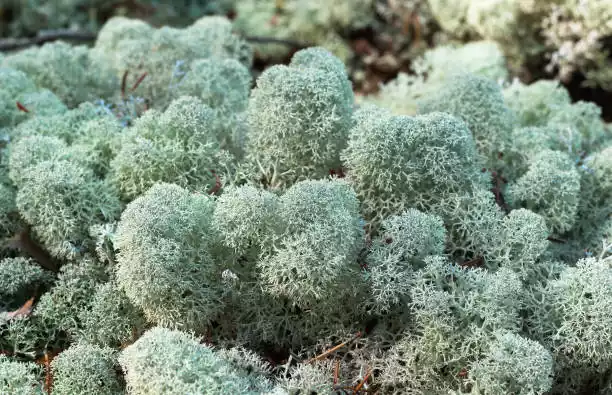
Characteristics of Fruticose Lichens
Fruticose lichens, with their distinct shrubby or bushy appearance, possess several unique characteristics:
-
- Three-dimensional Growth: Unlike the flattened structures of crustose and foliose lichens, fruticose lichens grow in a three-dimensional, often branched manner, giving them a bushy or hair-like appearance.
- Branched Structure: Many fruticose lichens have a branched thallus (body), which can be either densely or sparsely branched.
- Upright or Pendant: They can grow in various orientations, with some species growing upright from the ground or other substrates, while others hang down in a pendant fashion, often from tree branches.
- Round Cross-section: The branches or stems of fruticose lichens usually have a round cross-section, unlike the flattened structures of foliose lichens.
- Attachment: While some fruticose lichens are anchored at a single point, others may have multiple attachment points or can even grow freely without being attached.
- Differentiated Cortex: Fruticose lichens often have a differentiated cortex, which is the protective outer layer of the thallus, giving them varying textures and colors.
- Reproductive Structures: Like other lichens, fruticose species possess reproductive structures such as apothecia and perithecia for sexual reproduction. For asexual reproduction, they may produce structures like soredia, isidia, or even break off in fragments.
- Variability in Size: Fruticose lichens can range from tiny hair-like structures of just a few millimeters to large, bushy forms that are several centimeters or even meters long.
- Colors: Their color palette can be diverse, ranging from grays, greens, and yellows to more rare hues like blues or purples, depending on the species and environmental factors.
- Elasticity: Some fruticose lichens, especially those in arid regions, can be highly elastic. They become brittle when dry but regain their flexibility when moistened.
Fruticose lichens are a fascinating and diverse group, recognizable by their shrubby or hair-like appearance and the ability to grow in a three-dimensional manner. They play vital roles in ecosystems, from nutrient cycling to providing habitat for various small organisms.
Habitats & Distribution
Fruticose lichens exhibit a broad range of habitats, owing to their adaptability and diverse species composition. Their distribution spans across various ecosystems and climatic zones. Here’s an overview of their habitats and distribution:
- Global Distribution: Fruticose lichens are found worldwide, from the scorching deserts to the cold polar regions, from lowland forests to high mountainous areas.
- Forests: Both temperate and tropical forests are home to many fruticose lichens. They often dangle from tree branches or grow on tree trunks, especially in old-growth or undisturbed forests.
- Mountainous Areas: These lichens can be found at varying altitudes in mountain regions, often adorning rocks or soil.
- Arctic and Alpine Regions: In these cold environments, fruticose lichens play a crucial ecological role. They are a primary food source for some herbivores, such as reindeer and caribou.
- Deserts: Certain hardy fruticose species have adapted to desert life. They can endure extreme desiccation and rapidly rehydrate and become active with the slightest moisture.
- Grasslands: Here, fruticose lichens may grow directly on the ground, forming conspicuous tufts or mats.
- Coastal Areas: Some species thrive in coastal environments, benefiting from the consistent moisture from sea sprays and fogs.
- Urban Areas: While cities aren’t the most favorable environments for lichens due to pollution, some fruticose lichens can be found in urban parks, on trees, or other substrates.
- Islands: On both temperate and tropical islands, fruticose lichens can colonize various substrates, from tree canopies to coastal rocks.
- Caves and Overhangs: Some fruticose lichens grow in the dimly lit microenvironments of caves, grottos, and overhanging rocks, especially near cave entrances.
Their wide-ranging habitats underscore the versatility and ecological significance of fruticose lichens. Depending on the environment, they can serve as pioneer species colonizing barren landscapes, act as bioindicators of air quality, or provide vital sustenance to fauna in resource-scarce regions.
Comparison table of Crustose Foliose and Fruticose Lichens
Here’s a comparison table highlighting the primary differences between Crustose, Foliose, and Fruticose Lichens:
| Feature | Crustose Lichens | Foliose Lichens | Fruticose Lichens |
|---|---|---|---|
| Appearance | Flat and tightly adhered to the substrate | Leaf-like, partially attached structures | Bushy or hair-like, 3D growths |
| Attachment | Fully attached | Attached at various points | Loosely attached, sometimes dangling |
| Texture | Crusty | Flaky or leafy | Often fibrous or branched |
| Typical Habitats | Rocks, walls, tree trunks | Trees, rocks, soil | Trees, rocks, deserts |
| Thickness | Very thin | Moderate (can be peeled off in layers) | Variable, often thicker than other lichen types |
| Growth Form | Appressed to the substrate | Flat but with lobes or flaps | Erect or pendulous with cylindrical or branched structures |
| Reproductive Structures | Often on the lichen’s surface | Typically on the upper surface of the leafy lobes | Can be at the tips or throughout the lichen body |
| Durability | Resilient to extreme conditions | Prefer more humid environments | Adaptable to various conditions |
This table offers a concise overview of the distinctive features of each lichen type, making it easier to identify and differentiate them in natural settings.
Economic Importance of Crustose Foliose and Fruticose Lichens
Lichens, irrespective of their growth forms, have been utilized by humans for various purposes for centuries. The economic importance of crustose, foliose, and fruticose lichens spans across different industries and cultural practices:
- Dyes: Historically, lichens, especially certain species of foliose and fruticose lichens, have been used to produce dyes for wool, silk, and other fabrics. Different lichen species can produce a range of colors, from purples and reds to yellows and browns.
- Traditional Medicine: Lichens have been utilized in traditional medicine systems in various cultures. They have been used as remedies for ailments ranging from skin disorders to digestive issues.
- Perfume Industry: Certain lichens, notably the tree-dwelling Pseudevernia furfuracea and Evernia prunastri (oakmoss), are used as fixatives and base notes in the perfume industry due to their long-lasting scents.
- Food: Some lichen species, especially certain fruticose lichens, have been used as emergency food sources or as ingredients in traditional dishes. For instance, reindeer moss, a fruticose lichen, is consumed by indigenous populations in some Arctic regions.
- Alcoholic Beverages: Lichens have been used to flavor certain traditional alcoholic beverages in some cultures.
- Bioindicators: Lichens are excellent bioindicators of air quality. Due to their sensitivity to certain pollutants, the presence, absence, or abundance of specific lichen species can be used to gauge the level of air pollution in an area, aiding in environmental monitoring.
- Soil Formation and Erosion Control: Lichens, especially crustose types, play a crucial role in soil formation by breaking down rocks and contributing to the creation of initial soil layers. They also help in preventing erosion, especially in fragile ecosystems.
- Ecotourism: The aesthetic appeal of lichens, especially in pristine environments like old-growth forests and alpine regions, contributes to the attractiveness of these places for ecotourism.
- Research: Lichens are studied extensively in ecological, environmental, and even astrobiological research. They can provide insights into symbiotic relationships, survival in extreme conditions, and potential life on other planets.
- Lichenology: This field of study, focusing on lichens, provides employment opportunities for researchers, educators, and environmental consultants.
- Antibiotics and Pharmaceuticals: Some lichens produce compounds with antibacterial, antiviral, or antifungal properties, offering potential avenues for drug development.
Crustose, foliose, and fruticose lichens have diverse economic implications. Their multifaceted roles span from traditional uses to modern industrial applications and environmental significance.
Ecological Significance of Crustose Foliose and Fruticose Lichens
Each growth form of lichen—crustose, foliose, and fruticose—has its own set of ecological roles, but there are also general contributions that all lichens make to ecosystems. Here’s a breakdown of the ecological significance of these three types:
- Crustose Lichens:
- Pioneer Species: Often the first colonizers on bare rocks, crustose lichens secrete acids that help in breaking down the rock into soil. Their role in primary succession is pivotal.
- Erosion Prevention: By forming a tightly adhered crust on the substrate, they prevent soil and sand erosion, helping to stabilize dunes and other loose substrates.
- Bioindication: Many crustose lichens are sensitive to pollution and can act as bioindicators of air quality or the presence of specific contaminants.
- Soil Enrichment: As they decompose, they contribute essential minerals to the soil, enhancing its quality.
- Foliose Lichens:
- Nitrogen Fixation: Some foliose lichens, particularly those associated with cyanobacteria, can fix atmospheric nitrogen, enriching the soil.
- Habitat: Their leafy structure can provide microhabitats for small invertebrates, playing a role in biodiversity.
- Food Source: Larger and more conspicuous than crustose lichens, they can be a source of food for various animals, such as snails and some insects.
- Water Retention: Their broad surface allows them to absorb and retain water, aiding in moisture retention in some ecosystems.
- Fruticose Lichens:
- Food Source: In Arctic regions, fruticose lichens, like reindeer moss, are a primary food source for animals such as reindeer and caribou.
- Habitat Structure: Their branched, 3D structure provides habitat and breeding grounds for a variety of small animals and microorganisms.
- Erosion Control: Like other lichens, they help in binding the soil, preventing erosion in certain ecosystems.
- Air Quality Indication: Some fruticose lichens are particularly sensitive to pollutants and can serve as bioindicators.
- Water Storage: Their bushy or hair-like structures can trap moisture, providing a source of water in otherwise dry environments.
While all lichens play general ecological roles, the specific contributions of crustose, foliose, and fruticose lichens can vary based on their structural differences and habitats. Their combined roles in ecosystems underscore their importance in maintaining ecological balance and diversity.
Conclusion
Crustose, foliose, and fruticose lichens represent distinct growth forms of these remarkable symbiotic organisms. Crustose lichens adhere tightly to their substrates with a crusty appearance, foliose lichens display a leafy structure loosely attached to their bases, while fruticose lichens showcase a three-dimensional, often branched architecture.
Beyond their intriguing biological aspects, these lichens play pivotal roles in ecosystems, from soil formation to serving as bioindicators. Historically entwined with human culture, they’ve been utilized for dyes, medicines, and food, and continue to offer potential for modern applications in perfumery, research, and pharmaceuticals. The diversity and multifunctionality of these lichens underscore their ecological and economic importance in our world.

